We’re an affiliate. We hope you love the products we recommend! Just so you know, we may collect a share of sales or other compensation from the links on this page at no additional cost to you. Thank you if you use our links, we really appreciate it!
Homemade dog food recipes have gained popularity among pet owners looking to provide their furry friends with high-quality, nutritious meals. Making your own dog food allows you to control the ingredients and ensure that your dog is getting the best possible nutrition. Homemade dog food recipes can offer numerous benefits over commercial options, including better control over the quality of ingredients and the ability to cater to your dog’s specific dietary needs.
One of the primary benefits of homemade dog food is the ability to avoid the additives, preservatives, and low-quality fillers often found in commercial dog food. By preparing meals yourself, you can ensure that every ingredient is fresh and wholesome. This approach can also help with issues like allergies, digestive problems, and weight management, as you can tailor the recipes to your dog’s unique needs.
Moreover, homemade dog food can be more cost-effective than high-quality commercial options, especially if you buy ingredients in bulk. It also provides an opportunity to bond with your pet by ensuring they receive personalized, healthful meals.
In this comprehensive guide, we’ll explore why homemade dog food is beneficial, provide you with a variety of delicious recipes, and offer tips on transitioning your dog to a homemade diet.
Why Homemade Dog Food?
Understanding why homemade dog food might be the best choice for your pet can help you make informed decisions about their diet. Homemade dog food recipes offer several advantages over commercial dog foods, and addressing common concerns about homemade diets can ease any worries you might have.
Understanding the Benefits
Health Benefits: Homemade dog food allows you to customize your pet’s diet to address specific health concerns. For instance, if your dog suffers from allergies or sensitivities, you can avoid common allergens found in commercial foods, such as corn, soy, or artificial additives. Additionally, homemade food can be beneficial for dogs with weight management issues. By controlling portion sizes and ingredients, you can help maintain a healthy weight for your pet.
Cost Comparison: While high-quality commercial dog food can be expensive, homemade dog food can be a more economical option, especially if you buy ingredients in bulk. By preparing meals at home, you can also reduce packaging waste, which is better for the environment.
Common Concerns
Ensuring Balanced Nutrition: One of the biggest concerns about homemade dog food is ensuring that it provides a balanced diet. Dogs need a mix of proteins, carbohydrates, fats, vitamins, and minerals to stay healthy. It’s important to follow balanced recipes and consult with a veterinarian or a pet nutritionist to ensure that your dog’s diet meets all their nutritional needs.
Avoiding Harmful Ingredients: Certain foods are toxic to dogs and should be avoided in homemade recipes. Ingredients like onions, garlic, grapes, and chocolate can be harmful or even fatal. Always use dog-safe ingredients and double-check recipes for harmful substances.
Incorporating Proper Supplements: Homemade dog food should include supplements to fill in any nutritional gaps. Omega-3 fatty acids, calcium, and multivitamins are often necessary to ensure that your dog receives all the nutrients they need. You can add supplements or use fortified ingredients to achieve this.
Essential Ingredients for Homemade Dog Food
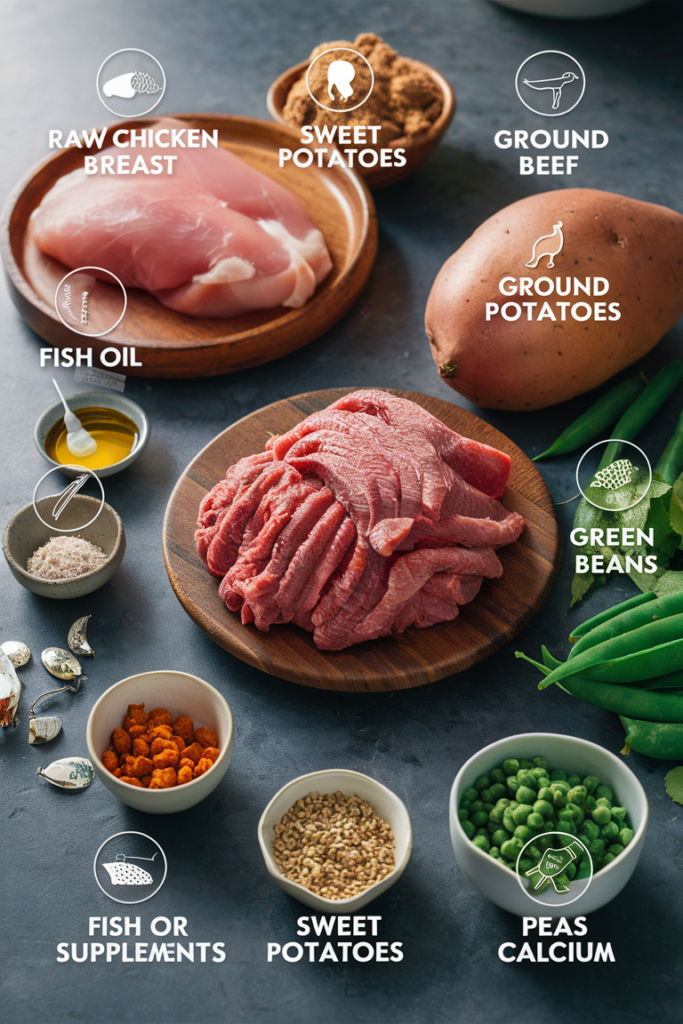
When preparing homemade dog food recipes, selecting the right ingredients is crucial for ensuring your dog’s diet is balanced and nutritious. Here’s a breakdown of the essential components you should consider for creating healthy, homemade meals for your furry friend.
Proteins
Types of Proteins: Proteins are fundamental for your dog’s growth, energy, and overall health. The most common protein sources in homemade dog food include:
- Chicken: A lean source of protein that’s easy to digest and rich in essential amino acids.
- Beef: Provides high-quality protein and important nutrients such as iron and zinc.
- Turkey: A lean meat that is lower in fat compared to chicken and beef, and is a good alternative for dogs with food sensitivities.
- Fish: Rich in omega-3 fatty acids, which support skin and coat health. Fish like salmon and sardines are particularly beneficial.
Benefits of Each Protein Source:
- Chicken and Turkey: High in protein and low in fat, these meats are great for maintaining muscle mass and energy levels.
- Beef: Contains a range of vitamins and minerals, including B vitamins and selenium, which support overall health.
- Fish: Offers omega-3 fatty acids that help reduce inflammation and promote a healthy coat.
Vegetables and Fruits
Safe Vegetables and Fruits for Dogs:
- Carrots: High in beta-carotene and fiber, which aid in vision and digestion.
- Green Beans: Low in calories and high in fiber, they help maintain a healthy weight.
- Sweet Potatoes: Rich in vitamins A and C, and a good source of dietary fiber.
- Apples: Provide vitamins A and C, and are a good source of fiber. Ensure to remove the seeds and core.
Nutritional Benefits:
- Carrots and Green Beans: Support healthy digestion and help with weight management.
- Sweet Potatoes: Boost immune function and provide energy.
- Apples: Aid in dental health and provide antioxidants.
Grains and Alternatives
Types of Grains:
- Rice: A good source of carbohydrates that provide energy and help with digestive issues.
- Oats: Rich in fiber and can aid in maintaining a healthy digestive tract.
- Barley: Offers a mix of vitamins and minerals, including B vitamins and iron.
Grain-Free Alternatives:
- Sweet Potatoes: Provide a high-quality source of carbohydrates and essential nutrients.
- Quinoa: A complete protein source that contains all nine essential amino acids.
Supplements
Essential Vitamins and Minerals:
- Calcium: Important for bone health. Can be added through crushed eggshells or a calcium supplement.
- Omega-3 Fatty Acids: Found in fish oil, these are crucial for maintaining a healthy coat and reducing inflammation.
- Multivitamins: Ensure your dog gets all necessary vitamins and minerals not provided by the primary ingredients.
Adding Omega-3 Fatty Acids and Probiotics:
- Fish Oil: Incorporate fish oil supplements to boost omega-3 fatty acids in your dog’s diet.
- Probiotics: Help maintain healthy digestion and can be added through probiotic supplements or specific dog-friendly yogurt.
Best Homemade Dog Food Recipes
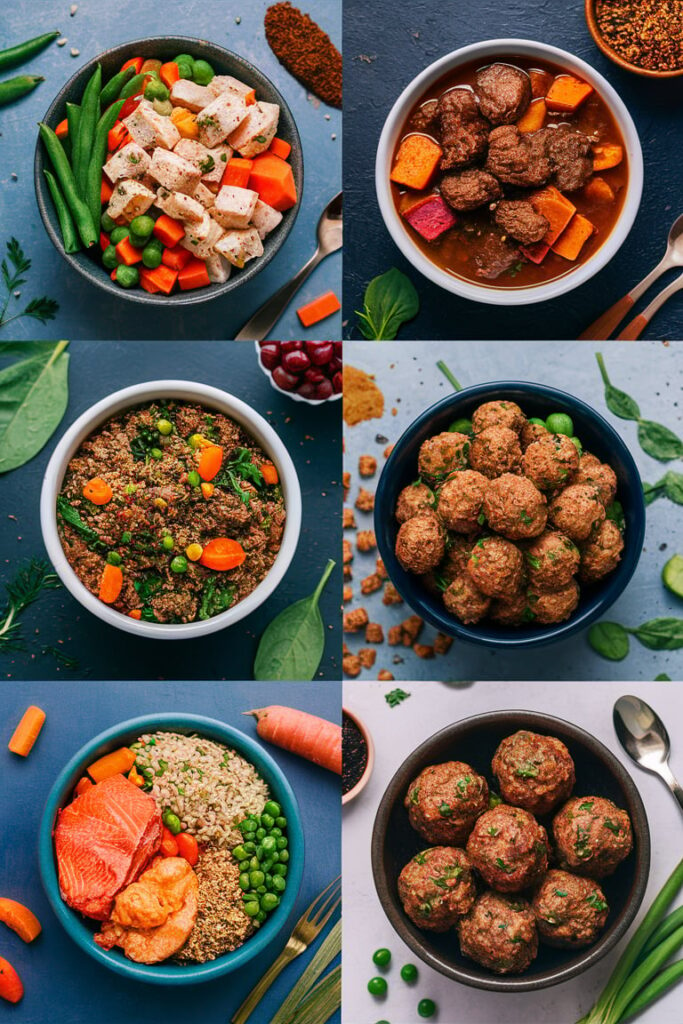
Creating nutritious and tasty meals for your dog at home can be a rewarding experience. Here are several homemade dog food recipes that are both healthy and delicious. Each recipe is designed to provide balanced nutrition while catering to different tastes and dietary needs.
1. Chicken and Vegetable Delight

Recipe Details:
- Prep Time: 10 minutes
- Cook Time: 20 minutes
- Total Time: 30 minutes
- Servings: 4
- Yield: 4 cups
Ingredients:
- 2 cups of diced chicken breast
- 1 cup of carrots, chopped
- 1 cup of green beans, chopped
- 1/2 cup of peas
- 1/2 cup of sweet potato, diced
- 1 tablespoon of olive oil
Preparation:
- Heat olive oil in a large non-stick pan over medium heat.
- Add chicken and cook until browned and fully cooked.
- Add carrots, green beans, peas, and sweet potato to the pan. Stir well.
- Cook for 10-15 minutes, or until vegetables are tender.
- Allow to cool before serving.
Nutritional Benefits:
- Chicken: Provides lean protein and essential amino acids, which are crucial for your dog’s muscle development and energy levels. For dogs with sensitive digestion, consider adding a high-quality probiotic supplement. [Highly Recommended]
- Carrots and Sweet Potatoes: Rich in vitamins A and C, fiber, and antioxidants that support eye health, immune function, and digestion. Add a multi-vitamin supplement for a balanced diet.
- Green Beans and Peas: Offer additional vitamins and minerals, including vitamins K and C, and are low in calories, making them ideal for weight management.
Variations:
- Add Spinach: For added iron, calcium, and vitamins, stir in a handful of fresh organic spinach in the last few minutes of cooking. Spinach is beneficial for your dog’s bone health and muscle function.
- Substitute Chicken: Use ground turkey or lean beef as an alternative protein source. Both are excellent options for dogs with chicken allergies or if you want to add variety to their diet.
Additional Tips:
- Add Quinoa or Brown Rice: If you want to add some healthy grains, mix in 1/4 cup of cooked quinoa or brown rice after the vegetables are tender. These grains provide additional fiber and help in maintaining a healthy digestive system.
- Include Herbs: You can add a sprinkle of parsley or rosemary for added flavor and health benefits. Parsley is known for its anti-inflammatory properties, while rosemary supports heart health.
Storage:
- Refrigeration: Store any leftovers in an airtight container in the refrigerator for up to 3 days.
- Freezing: You can freeze portions in a freezer-safe container for up to 3 months. Just thaw in the refrigerator overnight before serving.
Serving Suggestions:
- Serve on its own as a complete meal, or mix it with your dog’s regular high-quality kibble for added variety and nutrition.
- Portion Size: Adjust portion sizes based on your dog’s size and activity level. Smaller dogs may require half a cup per serving, while larger dogs may need a full cup.
Table: Nutritional Content per Serving
| Ingredient | Calories | Protein | Fat | Fiber |
| Chicken Breast | 165 | 31g | 3.6g | 0g |
| Carrots | 41 | 1g | 0.2g | 2.8g |
| Green Beans | 31 | 2g | 0.1g | 3.4g |
| Sweet Potato | 86 | 1.6g | 0.1g | 3g |
2. Hearty Beef and Vegetable Medley

Recipe Details:
- Prep Time: 10 minutes
- Cook Time: 25 minutes
- Total Time: 35 minutes
- Servings: 4
Ingredients:
- 1 pound of ground beef
- 1 cup of sweet potatoes, cubed
- 1 cup of carrots, sliced
- 1/2 cup of peas
- 1/2 cup of spinach
- 1/4 cup of water or low-sodium beef broth
Preparation:
- Cook ground beef in a large pot over medium heat until browned. Break up the meat into smaller pieces as it cooks.
- Drain excess fat from the beef to reduce the fat content, keeping the dish lean and healthy.
- Add sweet potatoes, carrots, and peas to the pot, stirring well to combine with the beef.
- Pour in water or beef broth and bring the mixture to a boil. Using low-sodium beef broth enhances the flavor without adding too much salt.
- Reduce heat and simmer for 20 minutes, or until the vegetables are tender and the sweet potatoes are easily pierced with a fork.
- Stir in spinach and cook for an additional 5 minutes, allowing the spinach to wilt and infuse the dish with extra nutrients.
- Optional: For an added boost to your dog’s gut health, sprinkle in a serving of PawBiotic Supplement just before serving. It supports healthy digestion and immune function, making it an excellent addition to any homemade meal.
- Cool before serving to ensure the meal is safe for your dog to eat.
Nutritional Benefits:
- Beef: A rich source of protein and iron, beef supports muscle development, energy levels, and overall health in dogs. For an added boost, consider incorporating a dog-safe omega-3 supplement to promote a shiny coat and healthy skin.
- Sweet Potatoes and Carrots: These vegetables are packed with vitamins A and C, which boost your dog’s immune system and promote healthy skin and coat. They also provide dietary fiber, aiding in digestion.
- Spinach: This leafy green adds a wealth of vitamins, including A, C, and K, along with antioxidants that protect your dog’s cells from damage and support overall well-being. Consider adding a multi-vitamin supplement to ensure balanced nutrition.
Variations:
- Add Apples: For a touch of natural sweetness, add a small, diced apple (without seeds) towards the end of cooking. Apples provide a good source of vitamin C and fiber, and many dogs enjoy their crisp texture.
- Substitute Beef: If your dog has dietary restrictions or you want to mix things up, use ground lamb or chicken as alternative protein sources. Lamb is rich in essential fatty acids, and chicken provides lean protein.
Additional Tips:
- Incorporate Grains: If you want to include grains in your dog’s diet, add 1/2 cup of cooked brown rice or quinoa to this recipe. These grains are gluten-free and offer additional fiber and nutrients.
- Batch Cooking: This recipe is perfect for batch cooking. Double the ingredients and store individual portions in the freezer for easy meal prep throughout the week.
- Serve with Dry Kibble: Mix this hearty dish with your dog’s regular dry kibble to provide a balanced and flavorful meal.
Storage:
- Refrigeration: Store any leftovers in an airtight container in the refrigerator for up to 3 days.
- Freezing: Freeze portions in a freezer-safe container for up to 3 months. Just thaw in the refrigerator overnight before serving.
Serving Suggestions:
- Serve as a standalone meal for a complete and balanced diet, or mix with kibble to add variety and enhance flavor.
- Portion Size: Adjust the portion size based on your dog’s age, size, and activity level. Smaller dogs may need 1/2 cup per meal, while larger dogs may require more.
Nutrition Facts (Per Serving)
| Nutrient | Amount |
|---|---|
| Calories | 250 kcal |
| Protein | 20 g |
| Fat | 10 g |
| Carbohydrates | 20 g |
| Fiber | 4 g |
| Vitamin A | 8000 IU |
| Vitamin C | 15 mg |
| Iron | 3 mg |
| Calcium | 40 mg |
3. Turkey and Quinoa Mix

Recipe Details:
- Prep Time: 10 minutes
- Cook Time: 15 minutes
- Total Time: 25 minutes
- Servings: 4
- Yield: 4 cups
Ingredients:
- 1 pound of ground turkey
- 1 cup of quinoa, cooked
- 1 cup of spinach, chopped
- 1/2 cup of carrots, diced
- 1/2 cup of peas
- 1 tablespoon of olive oil
Preparation:
- Cook ground turkey in a large pan over medium heat until fully cooked, breaking it into small pieces as it cooks. Turkey is a lean protein that is easily digestible, making it a great choice for dogs with sensitive stomachs.
- Stir in carrots and cook for 5 minutes, allowing the carrots to soften and blend with the turkey.
- Add spinach, peas, and cooked quinoa to the pan, mixing everything together. Spinach and peas contribute additional vitamins and minerals, while quinoa provides a complete protein source.
- Stir in olive oil and cook for an additional 5 minutes, ensuring the ingredients are well-coated and evenly heated. Olive oil adds healthy fats that support your dog’s skin and coat health.
- Allow to cool before serving to avoid burning your dog’s mouth.
Nutritional Benefits:
- Turkey: A great source of lean protein that supports muscle development and provides essential amino acids for overall health.
- Quinoa: A nutrient-dense grain that offers complete protein and is packed with essential amino acids, fiber, and minerals like magnesium and iron.
- Spinach and Carrots: These vegetables are rich in vitamins A, C, and K, along with dietary fiber and antioxidants that promote a healthy immune system, skin, and digestion.
Variations:
- Add Blueberries: For an antioxidant boost, mix in a handful of blueberries. Blueberries are known for their anti-inflammatory properties and can support cognitive function and heart health in dogs.
- Substitute Quinoa: If quinoa isn’t available, you can use brown rice or barley as alternative grains. Both grains provide fiber and additional nutrients, helping to keep your dog’s digestive system in check.
Additional Tips:
- Include Herbs: Add a pinch of turmeric or parsley to enhance the flavor and provide anti-inflammatory benefits. Turmeric can help with joint health, and parsley freshens breath and supports kidney function.
- Make it a Complete Meal: This recipe is balanced on its own, but you can mix it with dry kibble for added texture and flavor variety.
- Portion Control: Be mindful of your dog’s size and dietary needs when serving. Larger dogs may require a full cup, while smaller dogs might need just half a cup.
Storage:
- Refrigeration: Store leftovers in an airtight container in the refrigerator for up to 3 days.
- Freezing: Freeze portions in a freezer-safe container for up to 3 months. Thaw in the refrigerator overnight before serving.
Serving Suggestions:
- Serve as a complete meal or mix with kibble to add variety to your dog’s diet.
- Portion Size: Adjust the portion size based on your dog’s activity level, size, and dietary needs. Consult with your veterinarian if you’re unsure of the correct portion.
Nutrition Facts (Per Serving)
| Nutrient | Amount |
|---|---|
| Calories | 220 kcal |
| Protein | 18 g |
| Fat | 8 g |
| Carbohydrates | 18 g |
| Fiber | 4 g |
| Vitamin A | 7000 IU |
| Vitamin C | 10 mg |
| Iron | 2 mg |
| Calcium | 35 mg |
4. Fish and Rice Combo
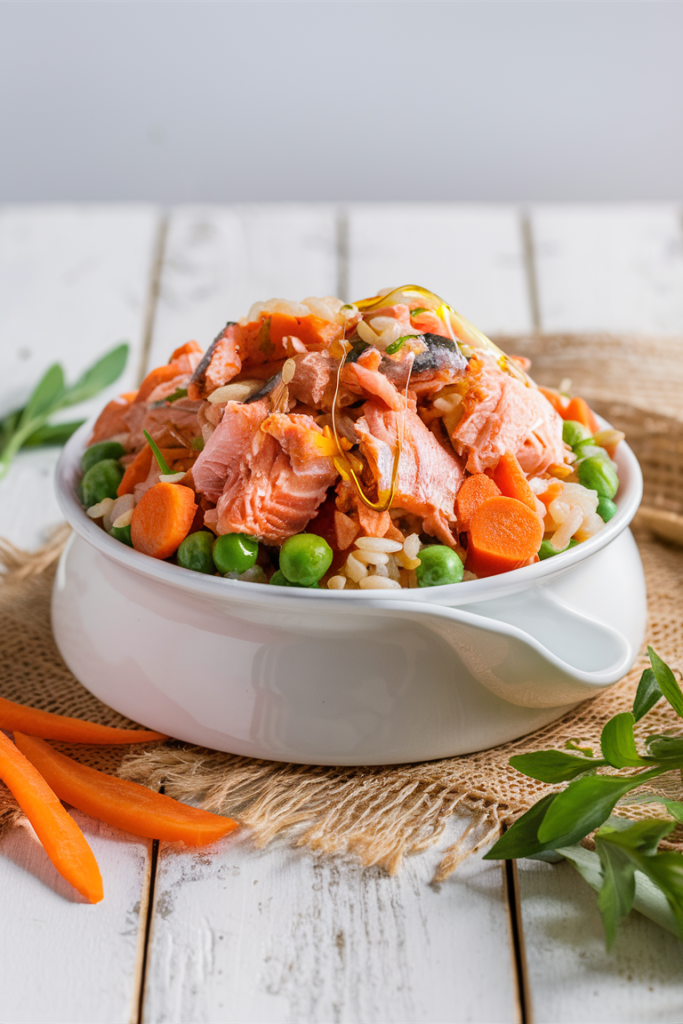
Recipe Details:
- Prep Time: 10 minutes
- Cook Time: 15 minutes
- Total Time: 25 minutes
- Servings: 4
- Yield: 4 cups
Ingredients:
- 1 pound of salmon, cooked and flaked
- 1 cup of brown rice, cooked
- 1/2 cup of peas
- 1/2 cup of carrots, chopped
- 1 tablespoon of fish oil (optional)
Preparation:
- Cook salmon and flake it into small pieces. Salmon is rich in omega-3 fatty acids, which are beneficial for your dog’s skin and coat health.
- Combine flaked salmon, cooked rice, peas, and carrots in a large bowl. Mixing these ingredients provides a balanced meal with a variety of nutrients.
- Stir in fish oil if using. Fish oil can enhance the nutritional profile with additional omega-3 fatty acids that support heart health and reduce inflammation.
- Cool before serving to ensure it is safe for your dog to eat.
Nutritional Benefits:
- Salmon: A high-quality protein source rich in omega-3 fatty acids, which promote a healthy coat, reduce inflammation, and support cognitive function.
- Brown Rice: Provides dietary fiber and carbohydrates for energy. It also aids in digestion and helps maintain a healthy weight.
- Peas and Carrots: These vegetables are packed with vitamins A and C, as well as antioxidants. They support overall health, improve immunity, and promote healthy skin and vision.
Variations:
- Add Pumpkin: For improved digestive health, mix in 1/4 cup of cooked pumpkin. Pumpkin is high in fiber and can help with digestion and regulate bowel movements.
- Substitute Salmon: If salmon is not available, use tuna or whitefish as alternatives. Both provide high-quality protein and essential fatty acids, although salmon is especially high in omega-3s.
Additional Tips:
- Add Herbs: Consider adding a small amount of parsley for additional health benefits. Parsley can help freshen your dog’s breath and support kidney health.
- Balance the Meal: This recipe is nutrient-dense on its own, but you can mix it with your dog’s regular kibble to provide variety and additional nutrients.
- Portion Control: Ensure the portion size matches your dog’s size and activity level. Adjust portions based on your dog’s specific needs.
Storage:
- Refrigeration: Store any leftovers in an airtight container in the refrigerator for up to 3 days.
- Freezing: Portion the meal into freezer-safe containers and freeze for up to 3 months. Thaw overnight in the refrigerator before serving.
Serving Suggestions:
- Serve as a complete meal or mix with dry kibble for added texture and variety.
- Portion Size: Adjust the portion size based on your dog’s weight and dietary needs. Smaller dogs may need about 1/2 cup per meal, while larger dogs may require more.
Nutrition Facts (Per Serving)
| Nutrient | Amount |
|---|---|
| Calories | 240 kcal |
| Protein | 22 g |
| Fat | 10 g |
| Carbohydrates | 20 g |
| Fiber | 4 g |
| Vitamin A | 7000 IU |
| Vitamin C | 12 mg |
| Iron | 1.5 mg |
| Calcium | 35 mg |
5. Veggie-Packed Meatballs

Recipe Details:
- Prep Time: 10 minutes
- Cook Time: 20-25 minutes
- Total Time: 30-35 minutes
- Servings: 4
- Yield: 20 meatballs
Ingredients:
- 1 pound of ground beef or turkey
- 1/2 cup of carrots, grated
- 1/2 cup of zucchini, grated
- 1/4 cup of oats
- 1 egg, beaten
Preparation:
- Preheat oven to 350°F (175°C).
- In a bowl, combine ground meat, grated carrots, zucchini, oats, and beaten egg.
- Mix thoroughly and shape into small meatballs.
- Place meatballs on a baking sheet and bake for 20-25 minutes, or until cooked through.
- Cool before serving.
Nutritional Benefits:
- Ground Meat: Provides high-quality protein essential for muscle development and overall health.
- Carrots and Zucchini: Add essential vitamins (A, C, and K) and moisture, which are beneficial for overall health and hydration.
- Oats: Contribute fiber for digestive health and help bind the meatballs, making them easier to handle.
Variations:
- Add Parsley: For fresh breath and additional nutrients, mix in a tablespoon of chopped parsley. Parsley also provides vitamins A, C, and K.
- Substitute Oats: Use ground flaxseed or breadcrumbs as a binding agent if you prefer. Flaxseed adds omega-3 fatty acids, while breadcrumbs can make the meatballs slightly more textured.
Additional Ideas:
- Veggie Additions: Consider adding other vegetables like spinach or bell peppers. Finely chop or grate them to blend into the meat mixture.
- Herb Blends: Experiment with different herbs such as basil, thyme, or rosemary for varied flavors and health benefits.
- Sauce Options: Serve with a low-sodium tomato sauce or homemade gravy to enhance flavor and moisture.
Serving Suggestions:
- Serve as a standalone meal or with a side of steamed vegetables.
- Pair with whole grain pasta or brown rice for a balanced meal.
Storage:
- Refrigeration: Store any leftovers in an airtight container in the refrigerator for up to 3 days.
- Freezing: Portion the meatballs into freezer-safe containers and freeze for up to 3 months. Thaw overnight in the refrigerator before reheating.
Nutrition Facts (Per Meatball):
| Nutrient | Amount |
|---|---|
| Calories | 70 kcal |
| Protein | 5 g |
| Fat | 3 g |
| Carbohydrates | 6 g |
| Fiber | 1 g |
| Vitamin A | 600 IU |
| Vitamin C | 4 mg |
| Iron | 1 mg |
| Calcium | 15 mg |
How to Transition Your Dog to Homemade Food
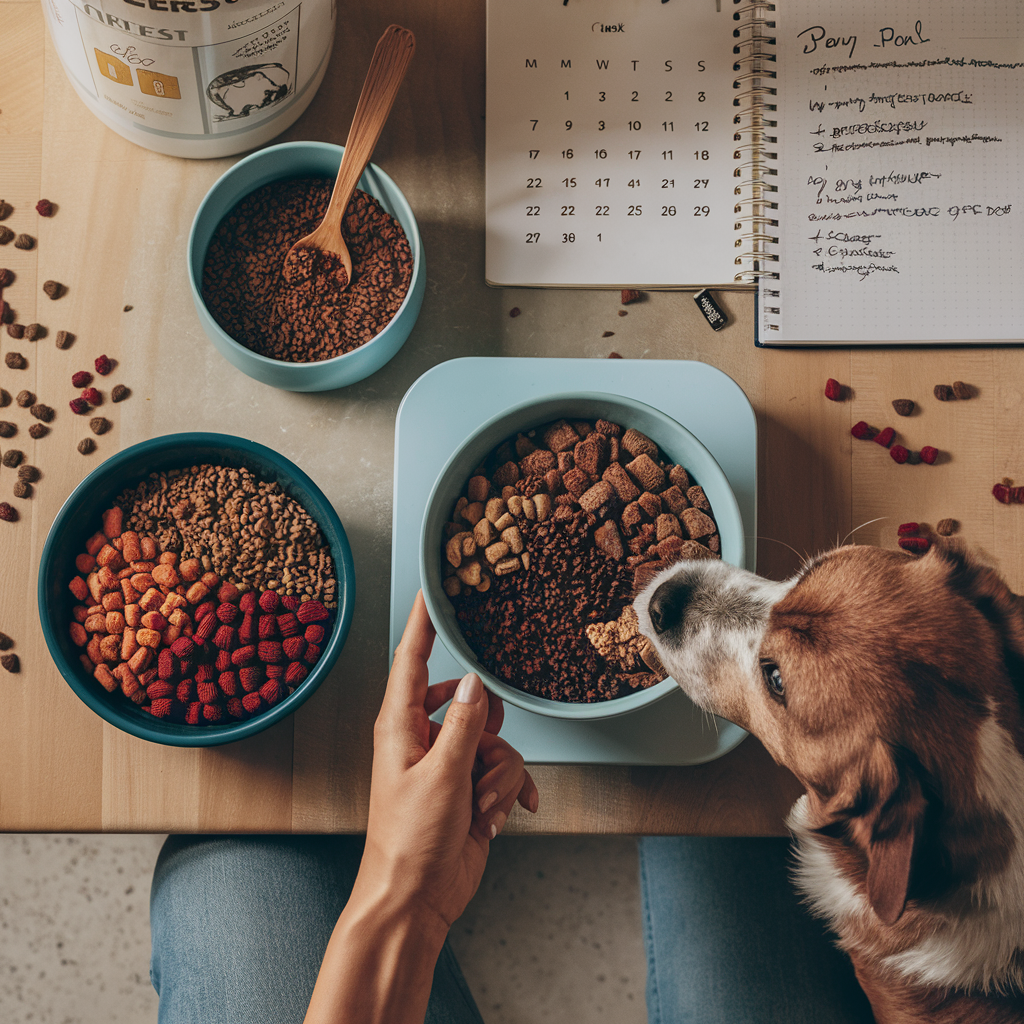
Transitioning your dog from commercial food to homemade dog food recipes requires a thoughtful approach to ensure a smooth changeover and to monitor your dog’s response to the new diet. Here’s a step-by-step guide to help you make the transition successfully.
Gradual Transition Tips
Mixing Homemade Food with Current Food:
- Start Slowly: Begin by mixing a small amount of homemade dog food with your dog’s current food. A good starting ratio is 25% homemade food to 75% commercial food.
- Increase Gradually: Over the course of 7-10 days, gradually increase the proportion of homemade food while decreasing the commercial food. Aim to reach a 100% homemade diet by the end of this period.
- Monitor Your Dog’s Response: Watch for any changes in your dog’s stool, energy levels, or overall health. If you notice any adverse reactions, consult with your veterinarian.
Monitoring Your Dog’s Reaction:
- Stool Consistency: Changes in diet can affect stool consistency. Ensure that your dog’s stool remains firm and regular. Soft stools or diarrhea might indicate a need to adjust the recipe or transition more slowly.
- Energy Levels: Pay attention to your dog’s energy levels. A balanced homemade diet should support healthy energy levels and overall vitality.
- Coat Condition: A well-balanced diet should result in a shiny, healthy coat. If you notice any changes in coat quality, it might be necessary to adjust the nutrient balance.
Signs of Allergies or Intolerances
Common Symptoms:
- Itching or Scratching: Excessive itching or scratching can be a sign of food allergies.
- Digestive Issues: Vomiting, diarrhea, or excessive gas might indicate a sensitivity to a particular ingredient.
- Ear Infections: Frequent ear infections can sometimes be related to food sensitivities.
Adjusting Recipes to Suit Your Dog’s Needs:
- Identify Trigger Foods: If you suspect a specific ingredient is causing issues, remove it from the recipe and substitute with an alternative.
- Consult a Veterinarian: A vet can help diagnose food allergies and recommend appropriate dietary adjustments or specialized recipes.
- Test New Ingredients: Introduce new ingredients one at a time to identify any potential allergens and ensure your dog’s tolerance.
Storing and Serving Homemade Dog Food
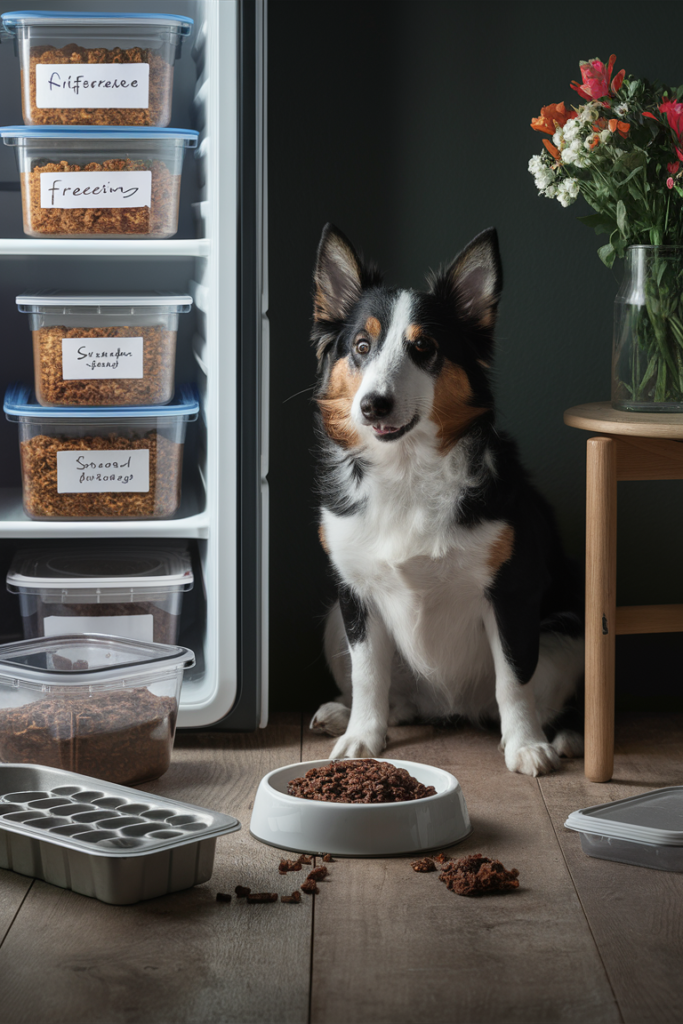
Proper storage and serving practices are essential for maintaining the quality and safety of homemade dog food recipes. Here’s how to ensure your homemade meals stay fresh and nutritious, and how to serve them correctly to your furry friend.
Proper Storage Methods
Refrigeration and Freezing Tips:
- Refrigeration: Store homemade dog food in airtight containers in the refrigerator. It is generally safe to keep refrigerated homemade dog food for up to 3-4 days.
- Freezing: For longer storage, freeze portions of homemade dog food. Use freezer-safe containers or resealable bags, and label them with the date. Frozen dog food can be stored for up to 3 months. Thaw in the refrigerator before serving.
Portion Control and Meal Prep:
- Portioning: Divide homemade dog food into individual meal portions to make feeding easier and prevent waste. Use ice cube trays or muffin tins to create portion-sized servings before freezing.
- Meal Prep: Plan and prepare meals in batches to save time. Having pre-portioned meals on hand ensures your dog receives fresh food consistently.
Serving Suggestions
Serving Sizes Based on Dog’s Size and Weight:
- Small Dogs: Typically require 1/4 to 1/2 cup of food per meal, depending on their weight and activity level.
- Medium Dogs: Generally need 1 to 2 cups of food per meal.
- Large Dogs: Often require 2 to 4 cups of food per meal.
Adding Supplements or Treats:
- Supplements: Add any recommended supplements, such as omega-3 fatty acids or calcium, according to your veterinarian’s advice. Mix them into the food just before serving.
- Treats: Offer healthy treats sparingly to avoid overfeeding. Use treats as a reward or supplement, but ensure they fit within your dog’s overall nutritional plan.
Common Mistakes to Avoid with Homemade Dog Food
Making homemade dog food is a great way to provide your pet with nutritious meals, but it’s essential to avoid common pitfalls to ensure your dog receives a balanced diet. Here are some frequent mistakes and how to prevent them.
Nutritional Imbalance
Ensuring Balanced Nutrition:
- Avoiding Single-Ingredient Meals: Relying on only one type of meat or vegetable can lead to nutritional deficiencies. Ensure a variety of ingredients are included to cover all essential nutrients.
- Consulting a Professional: Work with a veterinarian or pet nutritionist to create a balanced meal plan. They can help ensure the diet includes all necessary vitamins and minerals.
Common Signs of Nutritional Deficiencies:
- Coat Problems: Dull, dry fur or excessive shedding can indicate a lack of essential fatty acids or other nutrients.
- Digestive Issues: Consistent digestive problems like diarrhea or constipation might signal an imbalance in the diet.
Using Harmful Ingredients
Avoiding Toxic Foods:
- No Onions or Garlic: Both onions and garlic are toxic to dogs and should never be included in homemade recipes.
- No Grapes or Raisins: These can cause kidney failure in dogs and should be avoided.
- Avoiding Artificial Additives: Stay away from artificial colors, flavors, and preservatives, which can be harmful.
Checking Ingredients Thoroughly:
- Read Labels: When using prepared ingredients or supplements, always check labels to ensure they are dog-safe.
- Research New Ingredients: Before introducing new ingredients into your dog’s diet, verify their safety.
Incorrect Portion Sizes
Understanding Proper Portion Sizes:
- Avoid Overfeeding: Too much food can lead to obesity and related health issues. Follow portion guidelines based on your dog’s size and activity level.
- Adjusting for Weight Changes: Regularly monitor your dog’s weight and adjust portions as needed to maintain a healthy weight.
Monitoring Your Dog’s Weight and Health:
- Regular Weigh-Ins: Weigh your dog periodically to ensure they are maintaining a healthy weight.
- Veterinary Check-Ups: Regular check-ups can help monitor your dog’s overall health and ensure their diet is meeting their nutritional needs.
FAQs About Homemade Dog Food

If you’re considering switching to homemade dog food recipes, you might have several questions about the process, benefits, and potential concerns. Here are some frequently asked questions and detailed answers to help guide you.
1. Can I feed my dog homemade food exclusively?
Yes, but with Caution: Feeding your dog exclusively homemade food is possible, but it requires careful planning to ensure all nutritional needs are met. Dogs need a balanced diet that includes proteins, fats, carbohydrates, vitamins, and minerals. Homemade recipes should be well-rounded and prepared with guidance from a veterinarian or a pet nutritionist to prevent deficiencies.
Consultation is Key:
- Veterinary Advice: Before making homemade food your dog’s sole diet, consult with your veterinarian to create a balanced meal plan tailored to your dog’s specific needs.
2. How can I ensure my homemade dog food is nutritionally balanced?
Incorporate a Variety of Ingredients: Use a variety of protein sources, vegetables, and grains (or alternatives) to cover a broad spectrum of nutrients. Each ingredient brings different nutrients to the table, so diversity is essential.
Use Supplements Wisely:
- Vitamins and Minerals: Supplement your recipes with essential vitamins and minerals, such as calcium and omega-3 fatty acids, if needed.
- Professional Guidance: Work with a pet nutritionist to formulate recipes that meet all your dog’s nutritional needs.
3. How do I know if my dog is allergic to any homemade food ingredients?
Watch for Allergic Reactions:
- Symptoms: Common signs of food allergies include itching, digestive upset, ear infections, or changes in coat quality.
- Elimination Diet: Introduce new ingredients one at a time and monitor your dog’s response. This process can help identify any allergens.
Consult a Vet:
- Allergy Testing: Your veterinarian can perform tests to identify specific food allergies and recommend appropriate dietary adjustments.
4. Can I use leftovers from my own meals in my dog’s food?
Proceed with Caution: While using leftovers can be economical, not all human foods are suitable for dogs. Avoid leftovers that contain harmful ingredients such as onions, garlic, or high-fat foods. Ensure that any leftovers used are plain and free from seasoning.
Safe Practices:
- No Harmful Ingredients: Ensure leftovers are free from toxic ingredients and excessive salt or fat.
- Balanced Meals: Combine leftovers with other nutritious ingredients to ensure a balanced diet.
5. How should I adjust homemade dog food recipes for puppies or senior dogs?
Puppies:
- Higher Nutritional Needs: Puppies require higher levels of protein, fat, and certain vitamins for growth and development. Ensure their diet is specially formulated to meet these needs.
- Frequent Meals: Puppies often need to eat more frequently than adult dogs. Adjust portion sizes and feeding schedules accordingly.
Senior Dogs:
- Reduced Calories: Senior dogs may require fewer calories and lower fat to maintain a healthy weight.
- Joint Health: Include ingredients that support joint health, such as omega-3 fatty acids from fish oil.

Hi, I’m Ali Tarek, the founder of Animalsman. I’ve always been passionate about pets, especially dogs and cats, and I created this website to share practical tips, easy recipes, and helpful care advice for fellow pet lovers. My goal is to make pet care simple, enjoyable, and accessible for everyone. When I’m not writing or curating content, you’ll usually find me spending time with my furry friends or learning new ways to keep them happy and healthy.



